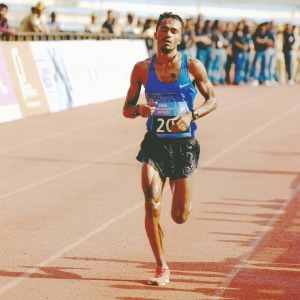
Nitendra Singh Rawat (Photo: courtesy Nitendra)
For now, the outdoor racing environment is in hibernation. India is in lockdown to combat COVID-19. Races have been cancelled or postponed and athletes (amateur and elite) are currently as much stay-at-home as anybody else. Improvising with what is available; strength training, catching up on rest – all these have become the name of the game.
Nitendra Singh Rawat is among India’s top marathon runners. In the countdown to the earlier schedule of the 2020 Tokyo Olympics (it has since been postponed to 2021), he had informed fans of injury and his decision to withdraw from attempts to qualify for the Olympic Games. Contacted in early April, Nitendra was home in Uttarakhand. The effects of injury had subsided a lot and the army athlete was back to his work outs and strength training exercises. However, he was still far from return to the same workout loads as before. Besides with the ongoing spread of COVID-19 and the postponement or cancellation of major sports events, there is little clarity in the world of sport for athlete to chalk out a map for the way ahead. “ My home is in the hills. It is not a crowded place,’’ Nitendra said of his surroundings.

Thomas Bobby Philip (Photo: courtesy Chetan Gusani)
“ For those who really want to do something, there is opportunity still. You have to motivate yourself,’’ Thomas Bobby Philip said. Bobby is among India’s best-known amateur runners; he has had several podium finishes in his age category. Locked down in Bengaluru, he has been feeding the runner in him with strength training exercises and exercises that aid flexibility. Once a week, he treats himself to a cardio workout, going up and down the stairs of his house. “ I have also started doing some calisthenics. This is the first time I am trying it. I hadn’t done that before,’’ he said. As for motivation, besides digging within to find it, Bobby pointed to many pursuing the active lifestyle who have begun offering online workout sessions. “ So, it is an interesting time,’’ he said. But as regards the return of normalcy with events back on schedule as in pre-lockdown times, Bobby felt that may take a long time. “ We are not in a situation where the path is clear. There will be restrictions and challenges ahead,’’ he said.

Satish Gujaran (Photo: courtesy Satish)
Satish Gujaran is a popular figure in Mumbai’s amateur running circles, especially with those planning to attempt the annual Comrades Marathon in South Africa. Satish has run the iconic event ten times. He used to provide coaching for those headed to Comrades but the lockdown has provided opportunity to further his online presence. In January 2020, Satish resigned his job and became the active face of an enterprise he and four others started: Karma Fitness (his existing coaching for Comrades was also brought under this umbrella). By February, the outfit was hosting sessions at Juhu beach in the city. Ever since lockdown commenced, Satish has been dispatching instructional videos every day designed to help people improve their fitness. “ We cater to both general fitness and fitness oriented towards running,’’ he said. According to him, response in these times of lockdown has been encouraging. He sends the videos to some 13 groups, each cluster having within it many individuals. The recipients are spread across 10-15 countries. “ They forward the videos further to their contacts. People seem happy to get it. I get feedback too; for example, somebody may ask for a specific type of exercise. We started sending the videos on the first day of lockdown in India. Initially, the videos were sort of mix and match. Now we are becoming systematic and more specific,’’ Satish said. He devotes an hour or two daily, to make the videos. It is shot early in the morning when natural lighting is apt or during other hours of the day with curtains used to control lighting. “ I live in a typical Mumbai flat. It is small. So there are limitations to what I can do under lockdown,’’ Satish said. The work keeps him busy. As for his personal workouts, Satish said that since he knows his body well, he either treats the exercises he does for the videos as his daily quota or sets some time aside for exercises of his own choice.

Naveen John (Photo: courtesy Naveen)
Naveen John is among India’s top bicycle racers. Cycling is mostly an outdoor sport and with India entering lockdown, Naveen has been restricted to being indoors in Bengaluru. “ For me as an athlete, it is out of question to stop my training,’’ he said. He turned to an e-racing platform called Zwift that allows cyclist to be indoors on a trainer and race using avatars against a global field. “ This e-platform has really taken off in the last few weeks. It had been there for some years but in the current situation, it is a kind of life saver,’’ Naveen said. He has been trying to get the athletes he coaches to also experiment with the platform. Their coaching sessions – including group rides – have gone online; it is all based on video calls now. At the heart of the whole transition is the trainer, a device that helps cyclist turn his regular road bike into a stationary cycle that he can still pedal. Naveen, who is known for his strict training, has reduced his overall workout volume. “ The good thing about training indoors is that the quality of work is better. There is no freewheeling or slowing down as in the outdoors, when you are on a trainer. It is steady, consistent power,’’ he said.
However, there is a drawback to the trainer. While one would assume that the contact of moving parts to the surface cycle is on (which contributes to resistance), is more while cycling outdoors, on a trainer, despite such contact reduced, the delivery of resistance is slightly imbalanced. “ The flywheel provides resistance in a certain portion of the pedal stroke. In the recovery stroke, the momentum of the flywheel carries you through,’’ Naveen explained. In turn this causes an imbalance in how muscles are engaged, with those muscle groups that usually come into play for the recovery stroke idling. Consequently the power you are able to produce while training indoors is 5-10 per cent less than what you can in the outdoors.
Naveen took some time to effect the transition to cycling indoors fully. It is a bit of a mental challenge. All athletes put themselves through suffering while training. “ The question: why are you punishing yourself? – it becomes real, a tough question to answer, when you are training indoors. One reason for this is that when you cycle outdoors, you are moving; there is world passing you by for motivation, variety and relief. The whole outdoors experience is also an aggregation of spiritual and chemical factors – there is the vitamin D, there is the sense of feeling good. All that is absent when training indoors. You have to rewire your motivational circuitry a bit,’’ Naveen said.
Finally, there is the issue of how much you push yourself because it is a fine line that separates over-training and compromising your immunity, and staying healthy. Naveen believes that while training for endurance is fine, it is the intensity one has to be watchful of. He has been advising his athletes to stick to a blend of 80 per cent endurance training (wherein you are below tempo pace) and 20 per cent at aerobic threshold. “ The feedback so far has been encouraging,’’ he said, adding that he was conditioned by experience to sense the immunity-compromised space that his body can slip into. “ I am aware of the negative toll it can take,’’ he said. He believes that most athletes are similarly wired to sense danger early enough and back off. As important as maintaining that 80:20 endurance to intensity ratio, is nutrition. In the early days of lockdown, Naveen said, it was tough sourcing proper nutrition and hydration. Preferred brands of sports nutrients were tough to get because e-sellers were having a hard time functioning. For the first time in several years, Naveen had to go back to basics and create his own mixtures for hydration. “ Things have since begun to improve, slowly,’’ he said. He is optimistic about life under lockdown. “ I tell myself that these challenging months are few in number compared to the nine years I have been a competitive cyclist so far,’’ he said.

Jyoti Gawate (Photo: courtesy Jyoti)
With races cancelled or postponed due to the spread of COVID-19, elite runner Jyoti Gawate could lower the volume and intensity of her training. Summer in India is also off season in the domestic racing calendar. Her focus changed to maintaining fitness levels. In the wake of lockdown in the country, she along with a few fellow athletes and their coach Ravi Raskatla moved out of Parbhani city in Maharashtra so that they may continue their fitness regimen away from crowded environment. “ We have been staying on the premises of a temple about 15 kilometers outside of Parbhani. It is hilly terrain. We have cut back on our training because there are no races on the horizon,” Ravi said. They do as much physical conditioning as is necessary to keep the momentum in training, going. “ We buy vegetables from the villagers who grow them. We cook our own food. That way, we are able to keep costs down,” he said. At the 2020 edition of Tata Mumbai Marathon, Jyoti had secured second position among Indian elite women, finishing the race in 2:49:13 hours. In December 2019, she had won bronze in the women’s marathon at the South Asian Games with timing of 2:52:44.

Sabhajeet Yadav (Photo: by arrangement)
“ I live on the edge of a village far away from crowds,’’ Sabhajeet Yadav, farmer and well known amateur runner said. Sabhajeet, who has been podium finisher in his age category, multiple times, at the annual Mumbai Marathon and other major events, stays in Dabhiya, in the Jaunpur district of Uttar Pradesh. Amid his attention currently focused on getting ready to harvest the wheat crop, he has been carrying out some light training.
Someone who participates in races to augment his regular income with prize money, he is worried about the absence of races for the few months ahead. In the wake of COVID-19, many races on the domestic circuit were cancelled or postponed. But it is due to a medical emergency capable of affecting all; so one has to accept it. In January, Sabhajeet had secured an age category podium at the 2020 edition of Tata Mumbai Marathon.
His son Rohit Yadav, a promising national level athlete competing in the javelin throw, is currently in Patiala. Rohit and Neeraj Chopra, national record holder in javelin throw, were in Turkey for training. “ They returned a day before lockdown and are now at the sports facility in Patiala,” Sabhajeet said.

Rohan More (Photo: courtesy Rohan)
It was roughly two years ago, in February 2018 that Pune-based Rohan Dattatrey More completed the Oceans Seven challenge in long distance swimming. Same year, he was inducted as Honouree Swimmer Class of 2018 by the International Marathon Swimming Hall of Fame. With Oceans Seven and another challenge called Triple Crown, in the bag, Rohan had shifted his attention to attempting qualification for the open water swimming competition at the 2020 Tokyo Olympics. He couldn’t meet the qualification time but at the national open water swimming competition held in Shimoga, Karnataka in February 2020, he placed second. Over the next one month, India steadily slipped into lockdown, an outcome of which was – all swimming pools shut. Unlike in some other countries where water quality is good and people easily take to rivers, lakes and seas; in India, the swimming pool is the hub of swimming. For committed athletes like Rohan, who love water as medium for exercise and mental peace, there was an element of readjustment to do. “ I do miss the pool. But there is no point complaining because it was shut for a valid reason. It is the same case elsewhere too. Not to mention – the current predicament isn’t just about athletes, it is about everybody’s health,’’ he said. Rohan has no exercise equipment at home. But the new work-from-home routine and the overall economic slowdown has left him with more time on his hands than before. So he works out twice every day; mostly free hand exercises to maintain fitness. Following the evening session, he also meditates briefly. On the bright side, the postponement of the Tokyo Olympics has given him more time to try qualifying for the open water swimming competition at the Games. “ You have to stay positive,’’ he said.

Srinu Bugatha (Photo: Shyam G Menon)
Srinu Bugatha was winner among Indian elites at the 2020 Tata Mumbai Marathon. At that time with most marathoners looking for opportunities to qualify for the Tokyo Olympics (as per earlier schedule before the event was postponed to 2021), Srinu had set his eyes on the 2020 Barcelona Marathon. As Spain got hammered by COVID-19, the Barcelona Marathon was among events postponed. In the weeks that followed, the disease spread in India as well causing the nation to resort to lockdown. An army runner usually training at the Army Sports Institute in Pune, when lock down set in Srinu returned to his hometown of Vizianagaram in Andhra Pradesh. According to Srinu, he has been continuing his training there as best as he can. He is doing his strength training albeit with no access to a gym as gyms are all shut. “ I do freehand exercises and core workouts,’’ Srinu said. Additionally, his mentor Vickrant Mahajan, said, the athlete is focusing on strengthening his mind and staying positive. You need those traits to do well in sports. The lockdown is good opportunity to take stock, reflect. On the bright side, the postponement of the Tokyo Olympics has opened up more time to train and qualify. With many marathons worldwide shifted to fall 2020, Srinu will be looking at events therein to attempt afresh, qualifying for the Olympics. “ The Barcelona Marathon has been rescheduled to October. We must stay positive and hope for the best,’’ Srinu said optimistically.
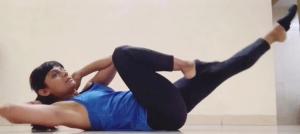
Priyanka Bhatt (Photo: courtesy Priyanka)
Mumbai-based ultra-marathon runner Priyanka Bhatt is part of the team representing India at the upcoming IAU 24-hour Asia & Oceania Championships at Bengaluru on July 18 and 19. Given the state of the world and major sports events cancelled or postponed, there is an element of uncertainty about the Bengaluru event as well. Priyanka was training despite that.
“ Obviously, you can’t burn as much calories in a home workout compared to a 40 or 50 km training run,’’ said Priyanka. She is using the current opportunity to build her strength. “ My workout is a mix of core, leg strengthening, HIIT, yoga and stretching,” she said. Strength, agility, functional training and flexibility often get neglected to some extent when the focus is on piling mileage for an ultra-marathon event, she said. Priyanka was part of the team that represented India at the 2019 IAU 24-hour World Championships held at Albi, France. She had covered a distance of 192.845 km during the 24 hours, securing a personal best.
At the current juncture, her workout ranges from about 45 minutes to an hour with 15 minutes of warm-up and cool down. “ I curate my own workout. I do a combination of exercises depending on what I have done the previous day,” Priyanka said.

Amit Samarth (Photo: courtesy Amit)
Amit Samarth is among India’s best known ultracyclists, having completed both Race Across America (RAAM) and the Trans-Siberian Extreme. Locked down in the city at India’s geographical center, he begins his day at six in the morning with a live work out session on Facebook, in which trainees from his sports academy and several others, participate. “ The academy has about 250 trainees. But the morning session on Facebook is open to all. I have been getting feedback from people overseas too,’’ Amit said. The session lasts between an hour to hour and half. However the hero of these days under lockdown seems to be the purchase he made roughly six months ago.
“ I used to have busy days that began pretty early. After finishing my work, it was typically late evening or night when I got around to cycling. My family and friends disapproved of me being out on a cycle in darkness. That’s how I bought the trainer six months ago. I wasn’t a major user of the device. But looking back, that now seems a lucky purchase because a home trainer is utterly useful for cyclist restricted by lock down,’’ Amit said. He has been using the training software: Zwift, mainly for customized rides and not for competing online. He conceded that the home trainer cannot replace the experience of cycling outdoors. “ It can be monotonous but I have the mental strength to endure that,’’ he said. Further the device has a few plus points. It eliminates distractions and allows cyclist to focus completely on the cycling. “ I maintain good speed, keep high cadence, try hill sections; the trainer automatically adjusts the resistance. Through all this, you don’t have to worry about traffic or getting a puncture. The mind-muscle co-ordination actually improves,’’ he said. And it seemed to be working well for him. “ Last week I covered 540 kilometers on my trainer,’’ he said. On the Sunday preceding this conversation, he did 200 kilometers in six hours 31 minutes. “ I started that session in the evening. By evening, the summer temperature in Nagpur becomes more tolerable,’’ he said.

Vijayaraghavan Venugopal (Photo: courtesy Vijay)
At his house in Hyderabad, amateur runner Vijayaraghavan Venugopal’s quest is avoidance of boredom. There are strict restrictions in his locality. “ I have stopped running. Besides if you try doing it, I don’t think it will be a good example in these times,’’ Vijay said. His lifestyle is very different now. I try and do multiple things,’’ he said. According to him, he has devised a variety of exercises in small doses that can be done easily and many times through the day. The variety helps to keep it engaging. “ My daughter is more disciplined at keeping herself physically fit. So once every 2-3 days, I join her for a half hour of exercise. I also do stair workouts once a week,’’ he said. A keen cricketer in his college days, Vijay said he and his family have also been improvising indoor games, including cricket tweaked to the confines of their rooms. “ Basically anything to keep mind and body active,’’ he said.
CEO of a company in the sports nutrition space (Fast & Up), Vijay said that the lockdown period is challenging to any enterprise related to sports because the whole sector has come to a halt. He was hopeful that things should improve marginally going ahead. After all, difficult times notwithstanding, people have to be kept safe in isolation without significant damage to their jobs and the economy at large. At a company like Fast & Up, which straddles products catering to daily nutrition and those meant for more performance based-objectives; there has been some demand for the former courtesy people keeping their active lifestyle alive despite lock down. The priority therein would be to get underlying e-delivery systems functioning efficiently so that products reach customers at their houses. “ The next three months will be challenging for the space we work in. The idea will be to see how lean and efficient we can be in that while,’’ Vijay said.
However business aside, as regards any semblance of normalcy returning to running is concerned, he conceded six months may be a more realistic time frame. One reason for this was signals currently emanating from the domestic world of sports. There has been speculation of a whittled down Indian Premier League (annual cricket tournament) and very recently the annual TCS World 10K, which is treated by many runners as start of a new year of running, was assigned fresh dates in September. Given the spread of COVID-19, you will know the true state of affairs only when the next few months go by. “ It will be a very cautious, slow return to how things were. That is also how herd behavior unfolds – you wait to see a move, you wait to see if it is safe, you wait to see how those you know are responding, you test the waters and then, slowly the old movement restarts,’’ Vijay said.

Kieren D’Souza (This photo was downloaded from the athlete’s Facebook page)
As someone who travels abroad every year to participate in ultramarathons, Kieren D’Souza has runner-friends in Europe and the US. “ In the US, they are still able to get in a run. But in Chamonix and Italy, they are allowed to be out only to buy groceries. My situation is somewhere between these two extremes,’’ Kieren said. For some years now, he has been living in Manali, part of a group of people – around ten of them – living on rent on two floors of a building with three. There is a small patch of land nearby where Kieren cultivates potato, herbs and kidney beans. Amid lockdown, he gets to step out there. “ Running pretty much stopped from a few days before lock down. I continue to do my work outs indoors,’’ he said. His day starts at around 7.30 AM, once the early morning chill of the Himalayan foothills has petered off. By 11 AM, he is on his trainer, a very basic one he acquired four years ago. For the next 2-3 hours he pedals. Post lunch, around 5 PM, he does strength training that addresses his legs, core and upper body. “ I have a bunch of basic equipment – some weights, pull up bar,’’ he said. Unlike many other ultrarunners in India, Kieren is unique in that he is a young person who set out to make a living from the sport. All his races till August have been cancelled by the respective race organizers and there is lack of clarity on when and how momentum in sports may revive. What COVID-19 and the lockdown may mean to sports and the travel industry is something that bothers him. Like other young people, he thinks about the economic situation forecast for the months ahead. “ Once the lockdown eases, I plan to tackle some pending projects,’’ he said. Meanwhile, he has learnt to bake. “ I make my own bread now,’’ he said.
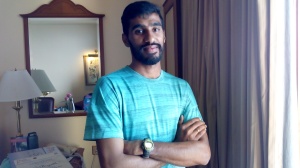
A.B.Belliappa (Photo: Shyam G Menon)
In January 2020, A. B. Belliappa had finished third in the half marathon at the year’s Tata Mumbai Marathon. As lockdown set in, the army runner hailing from Coorg in Karnataka took himself to a village in the state’s Hassan district, where he has been training to ensure his fitness levels don’t drop. Hassan has an average elevation of 3220 feet. “ I have been focusing on strength training and core workouts. The gyms are shut. So I train by myself,’’ Belliappa said when contacted. The logic he was following was simple. Since running is impossible now, he does his strengthening exercises in longer, stiffer doses. What supports this approach is that in the present circumstances, there is also more time available for rest and recovery. “ Although we are away, we can speak to our coaches when required,’’ he said.
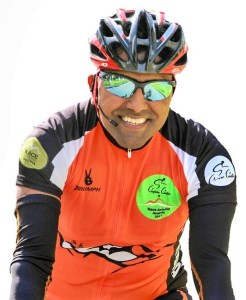
Lt Col Bharat Pannu (Photo: courtesy Bharat)
As the COVID-19 pandemic spread, Lt Col Bharat Pannu had a general sense of what to expect. The email of April 3, 2020 informing that the year’s RAAM had been cancelled wasn’t therefore completely surprising. Competitive athletes like a goal and RAAM had been Bharat’s for the last two years; his 2019 attempt had to be given up owing to injury. Ahead of the April mail from race organizers, he had kept alternatives in mind. He would aspire to do well in domestic bicycle races. But the lockdown in India added a new dimension – everyone, cyclists included, would have to be indoors. Committed cyclists like Bharat have trainers – devices that help convert a road bike into an indoor trainer – at home. With RAAM out of the picture, his training volume could be restored to normal levels. But the interesting thing was, as you talked to the army officer, you realized that his regular schedule was by no yardstick upset or compromised because he was limited to being indoors in Bengaluru. The training for cycling was going on as per plan. Every day (there is a day of rest too) he has a strength training session at home from 6AM to 8AM. The main difference was that the sessions were accompanied by a video conference call (on his phone) that allowed him and his friends to enjoy each other’s company as they worked out. “ We are a small group. Each day, one of us takes the lead in overseeing the session. We stay connected for the whole duration. In fact, we now feel we may not rejoin gyms after the lock down. This is working out pretty well, ’’ Bharat said, adding, “ sticking to your goals is important. Being flexible is even more important.”

Vikramgad’s runners. Dnyaneshwar is in the back row, second from left. This photo was taken in 2017 (Photo: Shyam G Menon)
Dnyaneshwar Morgha is well-known when it comes to podium finishes in the open category at races in Mumbai. He typically participates in distances of half marathon and less. He lives in Vikramgad, a little over 100 kilometers away from Mumbai. It is mildly undulating terrain. From a sufficiently high point, you can see the hills of Jawahar in the distance. Dnyaneshwar’s main source of livelihood is farming. A very good runner, he participates in races for the prize money, which helps bridge deficit in agricultural earnings. Locked down at his village in Vikramgad, his training is currently restricted to what he can manage indoors. “ I do strength training and stretching for about half an hour, every morning,’’ he said. Thanks to agriculture, the family has food to sustain them. But the earlier income that used to come from selling agricultural produce in the market – that has been impacted by lock down. “ We manage,’’ he said, adding, “ the summer period is usually a lean season for races and the lockdown is happening in summer. I wonder how the rest of the year will be.’’

Franco Linhares (Photo: Sharad Chandra)
Franco Linhares enjoys a special place in Mumbai rock climbing circles. At 69, he is one of the oldest, most consistently active rock climbers in the city. Not just that, regular climbing kept his grades in the sport quite decent making him an inspiration for youngsters. Weekends found him at the crags of Belapur in Navi Mumbai; during the week he visited any of the artificial climbing walls that have come up in Mumbai. Committed to the sport, he is among the early ones who opted for voluntary retirement from work and set out to pursue their passion. Now locked down at his home, Franco has been working out twice a day; 40-45 minutes in the morning, same quantum of time to sweat in the evening. One reason he has been regular at his workouts is that it helps him keep his climbing muscles active. “ If I don’t do my exercises, I risk surgery at some injured spots,’’ Franco said. Additionally he has a finger board – a board with features built into it that climbers love to do pull ups on or hang from – at home to stay engaged. This year he had been paying special attention to strengthening his knees with a view to resume running. “ My goal was to start running by May 1. Given the present state of affairs, I doubt if that will happen,’’ Franco said. The knee exercises however continue.

Girish Bindra (Photo: courtesy Girish)
Locked down in Mumbai, Girish Bindra devises his own workouts covering various aspects of fitness – core strength, functional training, HIIT. He often ends his workout with a barefoot walk or run inside his house. He does heavy workout that includes HIIT two or three times a week and also takes a day off once a week.
“ It is very important to focus on food intake, hydration and rest,” Girish said. A coach for Asics, Girish said practitioners of home workout should be conscious when to stop. “ Each person has a different capacity,” he said adding that the period of being home bound should be used to assess one’s workout capability. “ Being home bound, my sleep has improved as I am not required to wake up early to head out for a run,” Girish said.
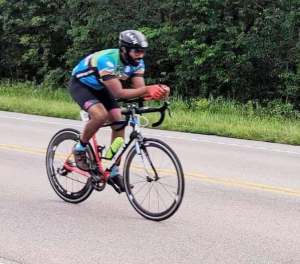
Kabir Rachure (Photo: courtesy Sapana Rachure)
Navi Mumbai-based Kabir Rachure had successfully completed RAAM in 2019. He was planning another attempt in 2020. Then two things happened. India went into lock down; in far off USA, 2020 RAAM was cancelled. With the event he was focusing on taken off the racing calendar, Kabir reduced his training load. Meanwhile lockdown meant no cycling outside and resorting to trusted trainer indoors. His day under lock down starts late. He sleeps late, gets up late and by evening treats himself to an indoor cycling session of an hour or two on the trainer. “ If it is an hour, then I do high intensity training; if it is two hours, then I do low intensity,’’ Kabir said. He has been using Zwift for the past two years. However he does not indulge in any interactive online racing with others. Instead, he trains alone with rides customized to his needs. “ A few days ago, we did have an online group ride involving a few of us. That was done via video conferencing. Chaitanya Valhal took the initiative to organize it. It was interesting,’’ Kabir said. Someone who has been into physical fitness and gym visits for long Kabir’s strength training was now composed of free hand exercises done at home. With lockdown, gyms have shut.

Shubham Vanmali (Photo: courtesy Shubham)
Shubham Vanmali is a young long distance swimmer with channel crossings and swims across straits to his credit, including pursuit of Oceans Seven. He conceded that swimming pools shutting down with resultant loss of access to water, impacted dedicated swimmers greatly. Water has a therapeutic effect. “ When pools shut, it wasn’t just the loss of physical activity. It affected you psychologically too. But then I cannot complain because at the moment there are people all over the world, who are affected so. It is something we have to cope with,’’ he said. When the lockdown started, the initial days were a struggle for him. His daily schedule went for a toss; he became a night owl sleeping at 6 AM and waking up at 5 PM. Then he realized he had to set things right. “ I got back on track. Now I sleep by 10 PM and get up at 5 AM. Managing my sleep schedule has emerged the most important thing for me,’’ Shubham, who lives in Navi Mumbai, said. By 6 AM, he commences a training routine. He does not have any exercise equipment at home. “ All I have are resistance bands, a stick and a skipping rope,’’ he said. But with some amount of creativity they suffice to train muscle groups critical for swimming. Sometimes the creativity goes beyond these three items. For instance, a laptop bag filled with stuff to be tad heavy doubles up as a kettle bell. A typical training session involves warm up, exercises and stretching. He does cardio workouts in the morning; strengthening exercises in the evening. After every three days of training, he takes a day off. A youngster aspiring for a career around his interest in sports, Shubham also devotes time to think about how best to prepare for the economically challenging times that lay ahead, past lock down.
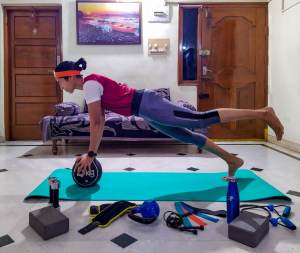
Ashwini G (Photo: courtesy Ashwini)
In February 2020, Ashwini G had secured a national best for women in the 12-hour run at the Tuffman Chandigarh Stadium Run. The Bengaluru-based runner covered a distance of 111.78 km. She had enrolled for the 100 km distance at Greater Noida Running Festival, which was to be held on March 14, 2020, and Ooty Ultra, slated for April 5. Both these events were cancelled.
“ I have no event on the cards. I should now focus on strength. Running is easier to do. Strength training requires a lot of discipline and dedication,” she said. Within strength training, her focus is on building endurance as she is largely into ultra-distance running. “ I do two sessions daily and these are complementary workouts,” she said adding that her home fitness regimen includes resistance band workout, jogs, walks, working out with dumbbells, agility training and core workout apart from yoga and foam rolling.

Dr Mahendra Mahajan (Photo: courtesy Mahendra)
For India, it was the Nashik based Mahajan brothers – both of them doctors – who opened the account at RAAM. In 2015, they had finished first among men under 50 in the two-person team category at RAAM. The brothers’ interests span cycling, hiking, mountaineering and running. When reached an evening early April, Dr Mahendra Mahajan was less than an hour from starting his daily workouts. “ We stay in a bungalow and are fortunate to have a gym on the terrace. We do our work outs together as a family,’’ he said. The sessions last between one to one and a half hours. “ The focus is mostly on strength training and exercises for the core,’’ he said. Sometimes, depending on his mood, the doctor works out twice a day. If that’s the case, then he tries to add variety and keep the sessions distinct. Two to three times a week, he cycles on the home trainer. He is an old hand at the trainer, having commenced using it in 2014. However, it’s a basic trainer and he is not on Zwift. “ With a basic trainer, it can sometimes be boring. But I manage with music or TV for company, to keep me going,’’ he said. He has also been using the time made available by lockdown to catch up on his reading – books on Everest feature on the list.
(The authors, Latha Venkatraman and Shyam G Menon, are independent journalists based in Mumbai. For more articles on the runners, cyclists, swimmers and climbers featured in this article, please type their name into the box assigned for search on the blog.)

































